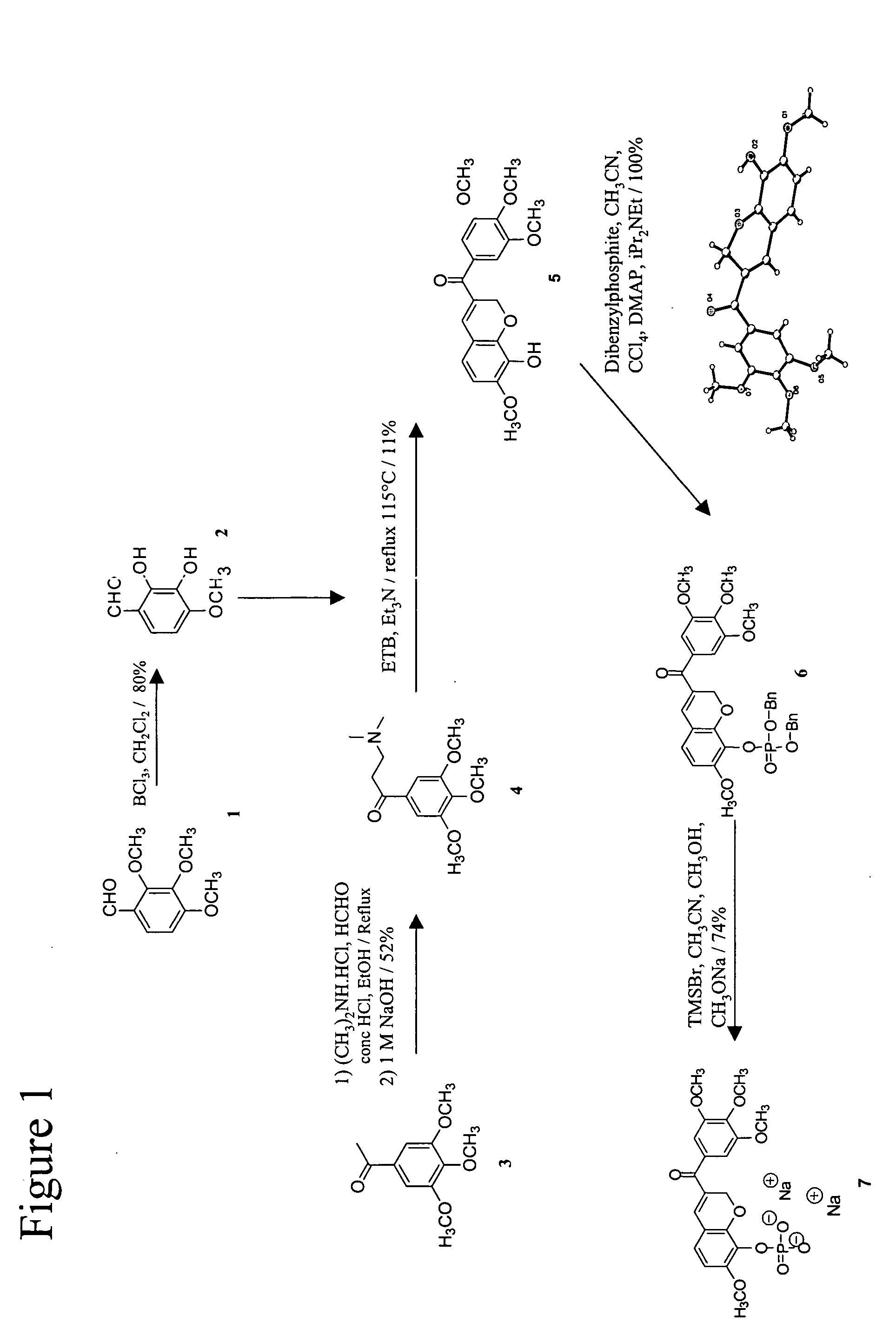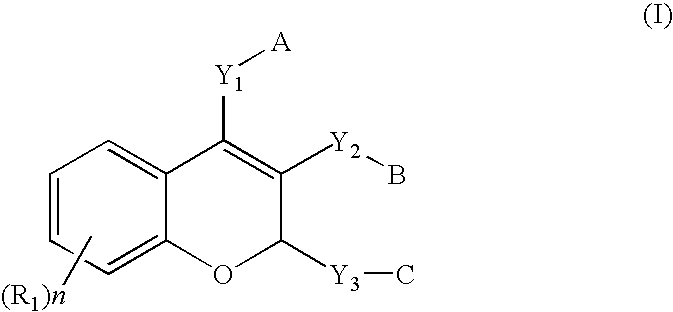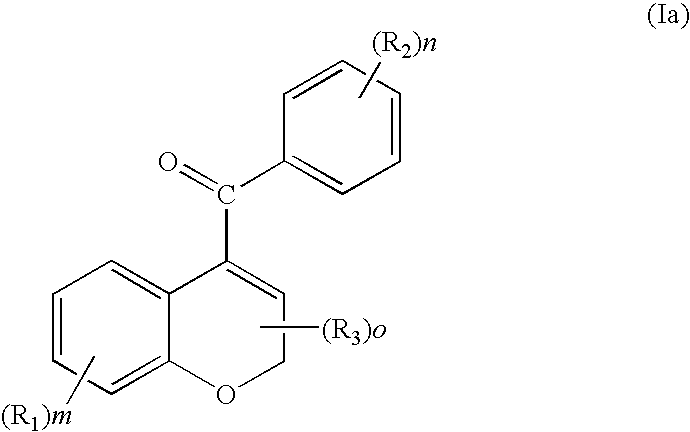Chromene-containing compounds with anti-tubulin and vascular targeting activity
a technology of vascular targeting and chrome-containing compounds, which is applied in the direction of heterocyclic compound active ingredients, drug compositions, biocides, etc., can solve the problems of tumor necrosis and manifest substantial normal tissue toxicity, and achieve tumor necrosis, normal tumor blood flow, and tumor necrosis. the effect of tissue necrosis
- Summary
- Abstract
- Description
- Claims
- Application Information
AI Technical Summary
Benefits of technology
Problems solved by technology
Method used
Image
Examples
example 1
Synthesis of 3-Aroylchromene Analogs and Corresponding Prodrugs
[0107] The exemplary chromene (3′,4′,5′-Trimethoxybenzoyl)-7-methoxy-8-(t-butyldimethylsilyloxy)-2H-chromene and its corresponding phosphate prodrug was synthesized as described in FIG. 1. Under Stetter conditions, the free base amine 4 and diol 2 condensed into the expected phenol 5 in reasonable yield.
[0108] X-ray crystallography confirmed the structure of 5 to be a unique chromene derivative, which had the trimethoxybenzoyl group in the P position with respect to the aryl ring.
i) 2,3-Dihydroxy-4-methoxy-benzaldehyde, 2
[0109] 2,3,4-trimethoxybenzaldehyde, 1 (9.8 g, 50 mmol) was dissolved in anhydrous dichloromethane (150 ml) under argon at ambient temperature. It was stirred for 10 minutes and boron trichloride (100 ml, 100 mmol, 2 eq; 1.0M solution in dichloromethane) was added. The dark reaction mixture was stirred for 24 hours and then slowly poured into 10% sodium bicarbonate (aq) (40 g / 360 ml). The resulting s...
example 2
Synthesis of Nitrogenated 3-Aroylchromene Analogs
[0139] In addition to the phosphate ester prodrugs that are described in this application for chromene-based anti-mitotic agents, it is envisioned that phosphorous based prodrug derivatives of nitrogenated chromenes may have therapeutic advantages as selective tumor vasculature destruction agents. These compounds are primarily serinainides, phosphoramidates, and related phosphate dianions that are assembled on an amino substituent of a chromene analog. When utilized in vivo, phosphoramidate analogs are able to provide a more soluble compound than the corresponding amine, thereby increasing the bioavailability of the parent drug. The P—N bond can be enzymatically cleaved by serum phosphatases releasing the amine which can inhibit tubulin assembly in a manner analogous to CA4P.
[0140] Furthermore, the carbonyl group of the benzoyl substituent can be replaced with an oxygen to generate a new compound which maintains the same or similar ...
example 3
Inhibition of Tubulin Polymerization
[0141] IC50 values for tubulin polymerization were determined according to a previously described procedure (Bai et al., Cancer Research, 1996). Purified tubulin is obtained from bovine brain cells as previously described (Hamel and Lin, Biochemistry, 1984). Various amounts of inhibitor were preincubated for 15 minutes at 37° C. with purified tubulin. After the incubation period, the reaction was cooled and GTP was added to induce tubulin polymerization. Polymerization was then monitored in a Gilford spectrophotometer at 350 nm. The final reaction mixtures (0.25 ml) contained 1.5 mg / ml tubulin, 0.6 mg / ml microtubule-associated proteins (MAPs), 0.5 mM GTP, 0.5 mlM MgCl2, 4% DMSO and 0.1M 4-morpholineethanesulfonate buffer (MES, pH 6.4). IC50 is the amount of inhibitor needed to inhibit tubulin polymerization 50% with respect to the amount of inhibition that occurs in the absence of inhibitor.
TABLE 1In Vitro Inhibition of Tubulin Polymerization.C...
PUM
| Property | Measurement | Unit |
|---|---|---|
| Flow rate | aaaaa | aaaaa |
Abstract
Description
Claims
Application Information
 Login to View More
Login to View More - R&D
- Intellectual Property
- Life Sciences
- Materials
- Tech Scout
- Unparalleled Data Quality
- Higher Quality Content
- 60% Fewer Hallucinations
Browse by: Latest US Patents, China's latest patents, Technical Efficacy Thesaurus, Application Domain, Technology Topic, Popular Technical Reports.
© 2025 PatSnap. All rights reserved.Legal|Privacy policy|Modern Slavery Act Transparency Statement|Sitemap|About US| Contact US: help@patsnap.com



